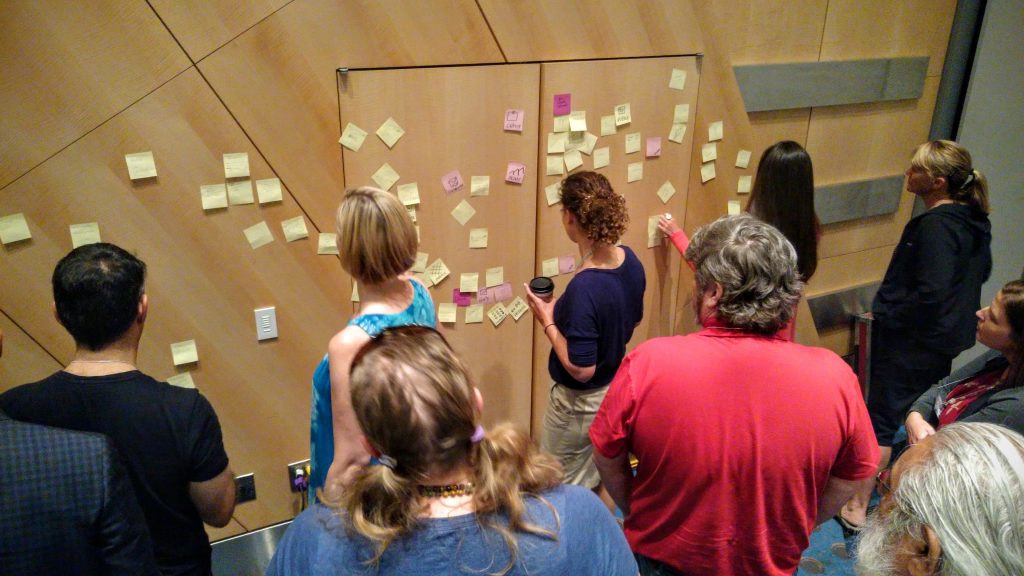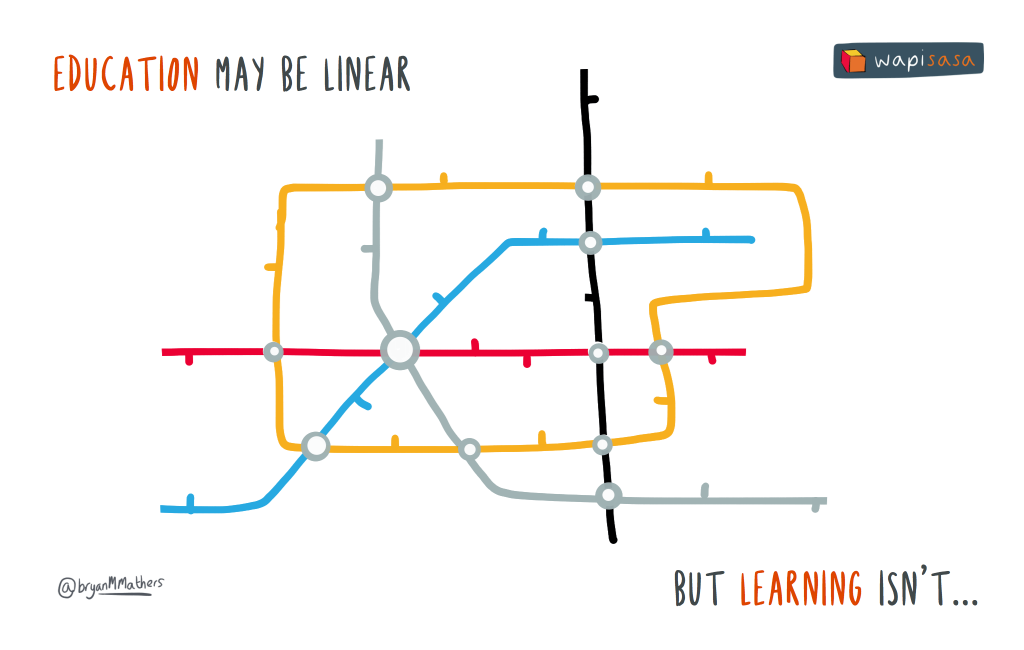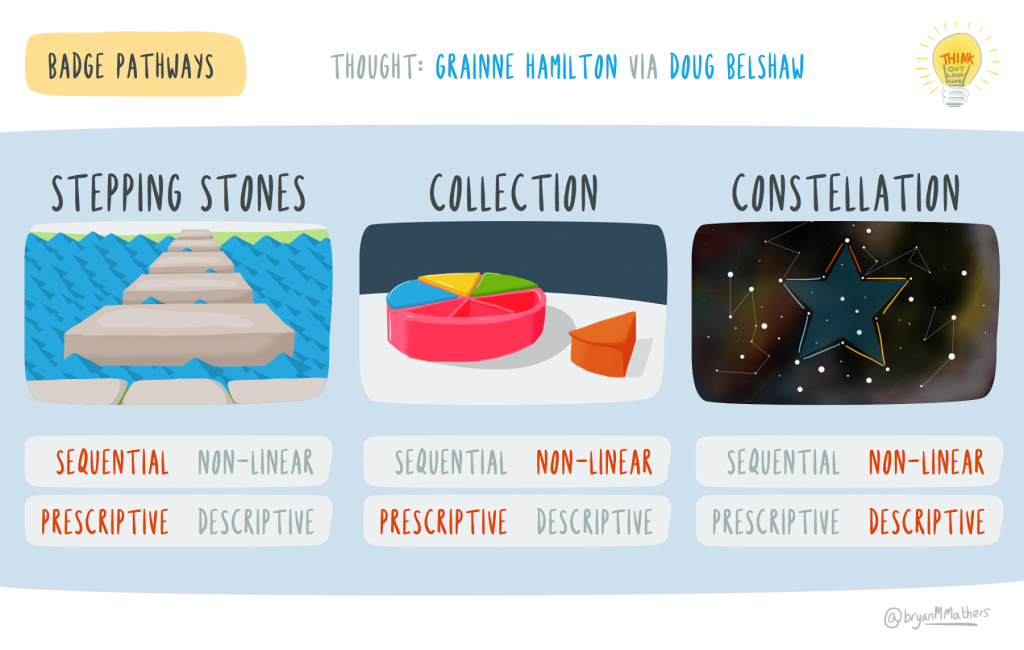How to use metaphors to generate badge-based pathways

A few days ago in Denver I co-facilitated a pre-ISTE workshop around badge pathways with Ian O’Byrne and Noah Geisel. Thanks to the power of the web, Bryan Mathers joined us remotely from his man shed back in London! It was a three hour session, with a wide range of participants, from those who had only just heard about Open Badges, to those who had started to design badge systems for their particular context.
Watch Ian’s archived Periscope recording of this session (~40 mins)
As part of the workshop, I used an approach from a couple of weeks beforehand when working with a client. It worked really well both times so, I wanted to document it so that you can benefit too! Many of you will have done similar kind of ‘human-centred’ design processes before, but for some it may be new.
As Marshall McLuhan famously said, “we look at the present through a rear-view mirror” and, as a result, “march backwards into the future”. In terms of badge system design, this means that we’re often constrained by what we’ve seen and experienced ourselves as both learners and teachers.
Rationale
The aim of this activity was to help people break out of the constraints and they didn’t even realise they had before getting started with designing badge pathways.
I’m a big believer that, consciously or unconsciously, we live a lot of our life through metaphor. We have mental models that help us make sense of the world and our place in it. One of these is what it means to ‘progress’ at something. While as educators we would freely admit to learning as being a messy affair, when it comes to demonstrating, mapping, or visualing ‘progression’ we tend to default to linear approaches.

5-step overview
- Prepare – Before you begin, ensure you have lots of post-it notes and pens (e.g. Sharpies) that will show up clearly. You’re welcome to use the illustrations from this post so long as you credit them (as I am!) CC BY-ND Bryan Mathers. He has other images you may also want to use at http://visualthinkery.com
- Input – Spend five minutes explaining how education may be linear, but learning certainly isn’t. Move on to explain that as educators we tend to stand on one side of the river, inviting students to walk across stepping stones. If they fall in, well they have to start again. Move on to describe the Trivial Pursuit model (pre-defined chunks of learning, but can be done in any order) and Constellation model (user entirely in control of pathways through ecosystem – make their own sense)
- Scribbling – Explain that participants will be expected to come up with as many metaphors as they can which could be used to demonstrate progression. One per post-it Take examples from the room in terms of what people are interested in. For example, if someone is into photography, they might use the ‘aperture’ settings on a camera as a metaphor. If someone drives a lot, they may use GPS as a metaphor. It could be as simple as a flight of stairs or a maze. Ensure that participants feel that it’s quantity, not ‘quality’ that counts, and that any suggestions will be accepted.
- Grouping – Depending on the confidence / cohesion of the group, you may want to first get them to compare notes where they’re sitting. The important thing to do now is to get those post-it notes up on a wall in a place where everyone can stand around. The post-its should be placed at random. Go through each one, reading it aloud, clarifying where necessary. Explain that the group will now spend time grouping the post-its together, however they think best. There are no right/wrong answers, just whatever they feel goes together.
- Classification – Once activity begins to slow, give participants a little more time, then go through each cluster of post-its, asking what each has in common. For example, one might have various metaphors that all involve there being a single destination, but multiple ways to get there. You’re then looking for a single word or phrase that will sum up the cluster. Write this on a different coloured post-it (if possible) and move onto the next cluster. As you go along, encourage people to move post-its, if they see fit.

Next steps
Once this activity is finished, you should have around five words or phrases that relate to different types of badge pathway. The group’s next activity could then be to come up with a subject to go with that metaphor. For example, if one of the pathways was ‘Surprise’ or ‘Discovery’ (perhaps the metaphors included peeling back the layers of an onion) then they could pair this up with building a badge pathway about taking care of online privacy. There are infinite possibilities!
Facilitator notes
- It’s important to ensure participants feel that they are in a ‘safe space’ so they can share ideas without being criticised. One way of doing this is to encourage everyone to use, “Yes, and…” as a way of responding to one another.
- You’ll need more post-it notes than you think! Factor in around 20 for each participant for this activity, just be sure you’ve got enough.
- It’s worth modelling the behaviour you want to see by doing the activity with participants. You could go around different tables writing down a couple of examples on each. This helps those that may be a little stuck (or lacking inspiration).
- Ensure you give enough time to do this activity without rushing. While it’s important to inject pace when appropriate, if it feels like a march towards an inevitable conclusion, participants are likely to be less forthcoming.
- Be as inclusive as possible. There are some people who, because they’re underconfident or sceptical, may add ‘jokey’ suggestions. Don’t ignore these, but include them in the clustering. For example, in the pre-ISTE workshop, there were quite a few around alcohol and drug use/misuse which we repurposed as ‘self-care’ or ‘looking after each other’.
- Encourage participants to take photographs. This means that when you transition back to seats, you can take the names of the five or so badge pathways with you quickly and easily.
Illustrations CC BY-ND Bryan Mathers

Do you like this example of working openly? You’ll love weareopen.coop! Follow us on Twitter or come and hang out in our Slack channel. All welcome!


Hi Doug
Intersestimg way to get people thinking about how they’re thinking. My background is linguistics (cognitive) and I’ve been hobbying (‘working’ is too official) with using metaphors for EFL / ESL training and cross cultural communication. I wasn’t 100% sure but it sounds like some of the language you’re using about metaphors is based on George Lakeoff and Mark Johnson’s work. I know some of Lakeoff and Johnson’s ideas have been challenged in the last few years (hey, it’s academia) but the basics imo still hold.
A not-so-quick example of interest piquing – when I first started teaching in the Arabian Gulf 14 years ago, I found it quite interesting how lying was handled socially. As a Canadian of Western European ancestory (acronym? Anybody?) lying is a personal offense and using the metaphor of ‘relationships as a journey’, a lie ‘blocks’ the path so that we cannot continue together until the block is removed i.e. there is an apology. If there is no apology or admission of wrong, anger, etc is seen as ‘allowed’. I noticed that this is not the case for the local population. Lying didn’t seem to block relationships or cause angry responses, at least in the interactions I’ve been witness to. In my 14 years of asking questions around this, many different aspects of culture, language, religion and metaphor have been raised. While I don’t have lots of answers (hobby, not work) it can’t be simply categorized as ‘saving face’ (a phenomenally complicated and non-linear topic itself). Metaphors around loyalty and fairness are probably key.
Anyway, thanks for your writing and collection of thought provoking ideas.
Thanks Bob – never really looked into the work of Lakoff or Johnson, but most of this comes from work around American Pragmatism and studies around ambiguity: http://ambiguiti.es